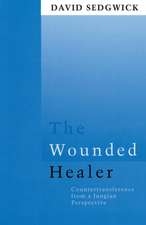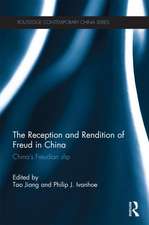Between Winnicott and Lacan: A Clinical Engagement
Editat de Lewis A. Kirshneren Limba Engleză Paperback – 17 feb 2011
Contributors: Jeanne Wolff Bernstein, James Gorney, Andre Green, Mardi Ireland, Lewis Kirshner, Deborah Luepnitz, Mari Ruti, Alain Vanier, Francois Villa .
| Toate formatele și edițiile | Preț | Express |
|---|---|---|
| Paperback (1) | 363.35 lei 6-8 săpt. | |
| Taylor & Francis – 17 feb 2011 | 363.35 lei 6-8 săpt. | |
| Hardback (1) | 1094.87 lei 6-8 săpt. | |
| Taylor & Francis – 4 mar 2011 | 1094.87 lei 6-8 săpt. |
Preț: 363.35 lei
Preț vechi: 382.47 lei
-5% Nou
Puncte Express: 545
Preț estimativ în valută:
69.53€ • 72.59$ • 57.54£
69.53€ • 72.59$ • 57.54£
Carte tipărită la comandă
Livrare economică 05-19 aprilie
Preluare comenzi: 021 569.72.76
Specificații
ISBN-13: 9780415883740
ISBN-10: 0415883741
Pagini: 192
Ilustrații: 2 b/w images
Dimensiuni: 152 x 229 x 11 mm
Greutate: 0.29 kg
Ediția:New.
Editura: Taylor & Francis
Colecția Routledge
Locul publicării:Oxford, United Kingdom
ISBN-10: 0415883741
Pagini: 192
Ilustrații: 2 b/w images
Dimensiuni: 152 x 229 x 11 mm
Greutate: 0.29 kg
Ediția:New.
Editura: Taylor & Francis
Colecția Routledge
Locul publicării:Oxford, United Kingdom
Public țintă
Postgraduate, Professional, and Professional Practice & DevelopmentCuprins
Kirshner, Introduction. Luepnitz, Thinking in the Space Between Winnicott and Lacan. Green, The Bifurcation of Contemporary Psychoanalysis: Lacan and Winnicott. Gorney, Winnicott and Lacan: A Clinical Dialogue. Ireland, Vicissitudes of the Real: Working Between Winnicott and Lacan. Kirshner, Applying the Work of Winnicott and Lacan: The Problem of Psychosis. Vanier, The Object Between Mother and Child: From Winnicott to Lacan. Bernstein, The Space of Transition Between Winnicott and Lacan. Ruti, Winnicott with Lacan: Living Creatively in a Postmodern World. Villa, Human Nature: A Paradoxical Object.
Notă biografică
Lewis Kirshner, M.D., is Clinical Professor of Psychiatry, Harvard Medical School, and Training and Supervising Analyst, Boston Psychoanalytic Institute. He is the author of Having a Life: Self Pathology after Lacan (Analytic Press, 2003), and has led workshops and meetings of the American Psychoanalytic and International Psychoanalytical Associations on "Working between Winnicott and Lacan."
Recenzii
"Winnicott and Lacan are arguably two of the most important psychoanalysts after Freud. Who would have thought that their methods and techniques could converge in clinical practice? I wondered how it could work. This book shows how it can be done and makes a strong case for the advantages of combining the contributions of these two psychoanalytic innovators. These essays, rich in clinical material, will intrigue all who are interested in the talking cure. This unique book will also be a valuable teaching tool. Between Winnicott and Lacan brings fresh perspective for rethinking psychoanalytic theory and practice." - Patricia Gherovici, Ph.D., author, Please Select Your Gender: From the Invention of Hysteria to the Democratizing of Gender (Routledge, 2010)
"This volume breaks new ground in opening up a dialogue between the seemingly divergent ideas of psychoanalysts Donald Winnicott and Jacques Lacan. Essentially (but not entirely) a clinical book, the authors bring for discussion familiar concepts - transitional phenomena, the ego and the mirror stage, subjectivity, the true and false self, human nature, lack, among others - offering interpretations of their similarities and differences that challenge us anew in our understanding in the consulting room. Between Winnicott and Lacan stimulates us to question the relationships between different theoretical paradigms without collapsing them into a confusing eclecticism, and helps to refresh our approach to what is useful in the clinic." - Angela Joyce, Ph.D., co-editor, Reading Winnicott
"For Lacan, abstract theory and the function of the father are pivotal. For Winnicott, clinical practice and the presence of the mother are crucial. This difference is reflected in their most famous inventions: Lacan's objet a denotes an irretrievable lack, Winnicott's transitional object an attempt to instill separation. In the best of both worlds a marriage between these objects and their protagonists can be imagined - and this book is an excellent starting point. Clinicians from both sides discuss how Lacan and Winnicott have inspired them in their clinical practice, while at the same time producing surprising conceptual links. A new middle group is in the making, and thanks to the efforts of Lewis Kirshner, we can participate in its first steps." - Paul Verhaeghe, Ph.D., University of Ghent, Belgium
"In its sustained theoretical and clinical engagement with Donald Winnicott and Jacques Lacan, Kirshner's collection argues for their value in advancing an understanding of what makes psychoanalysis - and life itself - meaningful." - Lesley Caldwell, Ph.D., editor, the Winnicott Trust
"This is the first time I have read a book about psychoanalytic practice where Lacanian ideas have come to life in an accessible way...This book cannot be summed up easily- it is full of complex and sometimes contentious ideas and really deserves a wide readership. It creates a potent relationship between two different kinds of psychoanalysis and opens up possibilites of greater understanding of clinical situations and theory for anyone interested in psychic life." - Geraldine Shipton, University of Sheffield, UK
"This volume breaks new ground in opening up a dialogue between the seemingly divergent ideas of psychoanalysts Donald Winnicott and Jacques Lacan. Essentially (but not entirely) a clinical book, the authors bring for discussion familiar concepts - transitional phenomena, the ego and the mirror stage, subjectivity, the true and false self, human nature, lack, among others - offering interpretations of their similarities and differences that challenge us anew in our understanding in the consulting room. Between Winnicott and Lacan stimulates us to question the relationships between different theoretical paradigms without collapsing them into a confusing eclecticism, and helps to refresh our approach to what is useful in the clinic." - Angela Joyce, Ph.D., co-editor, Reading Winnicott
"For Lacan, abstract theory and the function of the father are pivotal. For Winnicott, clinical practice and the presence of the mother are crucial. This difference is reflected in their most famous inventions: Lacan's objet a denotes an irretrievable lack, Winnicott's transitional object an attempt to instill separation. In the best of both worlds a marriage between these objects and their protagonists can be imagined - and this book is an excellent starting point. Clinicians from both sides discuss how Lacan and Winnicott have inspired them in their clinical practice, while at the same time producing surprising conceptual links. A new middle group is in the making, and thanks to the efforts of Lewis Kirshner, we can participate in its first steps." - Paul Verhaeghe, Ph.D., University of Ghent, Belgium
"In its sustained theoretical and clinical engagement with Donald Winnicott and Jacques Lacan, Kirshner's collection argues for their value in advancing an understanding of what makes psychoanalysis - and life itself - meaningful." - Lesley Caldwell, Ph.D., editor, the Winnicott Trust
"This is the first time I have read a book about psychoanalytic practice where Lacanian ideas have come to life in an accessible way...This book cannot be summed up easily- it is full of complex and sometimes contentious ideas and really deserves a wide readership. It creates a potent relationship between two different kinds of psychoanalysis and opens up possibilites of greater understanding of clinical situations and theory for anyone interested in psychic life." - Geraldine Shipton, University of Sheffield, UK
Descriere
D. W. Winnicott and Jacques Lacan are arguably two of the most important psychoanalytic theoreticians since Freud, and, somewhat ironically, seemingly two of the most incompatible. Lewis Kirshner and his colleagues attempt to demonstrate how the intellectual contributions of these two figures - such as Winnicott's self and Lacan's subject - complement productively despite their apparent contrast. Throughout the book, their major concepts are clarified and differentiated, but always with an eye toward points of intersection and a more effective psychoanalytic practice. Furthermore, these contributors address the Winnicott-Lacan relationship itself and the evolution of their respective theories, peppered with detailed clinical examples of how integrations of their ideas have been utilized with patients directly.














